Equimolar As4S4/Fe3O4 Nanocomposites Fabricated by Dry and Wet Mechanochemistry: Some Insights on the Magnetic–Fluorescent Functionalization of an Old Drug
Abstract
1. Introduction
2. Materials and Methods
2.1. Two-Step Mechanochemical Synthesis of Equimolar As4S4/Fe3O4 Nanocomposites
2.2. Microstructure Characterization of the Pelletized Nanocomposites
2.3. Functional Characterization of the Nanocomposites
3. Results and Discussion
3.1. On the Microstructure Specificity of Equimolar As4S4/Fe3O4 Nanocomposites
3.2. On the Fluorescence Functionalization of As4S4/Fe3O4 Nanocomposites
3.3. On the Magnetic Co-Functionalization of Fluorescent As4S4/Fe3O4 Nanocomposites
3.4. Specific Core–Shell Arrangement of Crystallites Tuning Magnetic–Fluorescent Functionalization of As4S4/Fe3O4 Nanocomposites
4. Conclusions
- The arsenical component is typically stabilized in the nm-sized high-temperature monoclinic nc-β-As4S4 phase, supplemented by a great amount of a continuously generated iso-compositional amorphous a-AsS substance, testifying in favor of the “shell” kinetic model of nanomilling-driven solid-state amorphization.
- The surfactant-capped nanocomposites fabricated in an aqueous Poloxamer solution can be subjected to contamination from the applied wet-milling facilities. Nanocrystalline–amorphous zirconia, as main products of such contamination, can essentially suppress the crystalline behavior of the principal nanocomposite constituents.
- The fluorescence and magnetic properties of the nanocomposites derived by dry or wet mechanochemistry are intricate, being tuned not only by the sizes of the constituent nanoparticles, but also by their interfaces, dependent on natural ageing after nanocomposite sample fabrication.
- The surfactant-stabilized arsenical crystallites (nc-β-As4S4) obeying nm-sized quantum confinement, can be stabilized as efficient fluorescent media possessing multicomponent emission in the blue region of the spectrum. A specific core–shell arrangement, consisting of inner and outer shell interfaces hosting an amorphous a-AsS phase and capping agent, is responsible for the blue-cyan fluorescence peaking at ~417 nm and ~442 nm in the as-fabricated surfactant-capped β-As4S4/Fe3O4-PX nanocomposites. The disappearance of this fluorescence under the long-term natural storage of the nanocomposites is explained in terms of the destroyed core–shell architectures of the constituent nanoparticles.
- The magnetic functionalization of both the surfactant-free and surfactant-capped As4S4/Fe3O4 nanocomposites is determined by their size-extended heterogeneous shells (around homogeneous nc-c-Fe3O4 cores), which possess a structural disordering character from the admixture of an amorphous a-AsS phase derived from nanostructured arsenical, agents of possible contamination (such as nanocrystalline–amorphous zirconia) and the surfactant (such as Poloxamer 407).
Author Contributions
Funding
Data Availability Statement
Acknowledgments
Conflicts of Interest
References
- Roduner, E. Nanoscopic Materials: Size-Dependent Phenomena; RSC Publ.: Cambridge, UK, 2006; pp. 1–285. [Google Scholar]
- Fatima, L.; Asghar, A.; Sajeev, C. Multiparticulate formulation approach to colon specific drug delivery: Current perspectives. J. Pharm. Pharmaceut. Sci. 2006, 9, 327–338. [Google Scholar]
- Dilda, P.J.; Hogg, P.J. Arsenical-based cancer drugs. Cancer Treat. Rev. 2007, 33, 542–564. [Google Scholar] [CrossRef] [PubMed]
- Liu, J.; Lu, Y.; Wu, Q.; Goyer, R.A.; Waalkes, M.P. Mineral Arsenicals in Traditional Medicines: Orpiment, Realgar, and Arsenolite. J. Pharm. Exp. Ther. 2008, 326, 363–368. [Google Scholar] [CrossRef] [PubMed]
- Liu, G.; Song, Y.; Li, C.; Liu, R.; Chen, Y.; Yu, L.; Huang, Q.; Zhu, D.; Lu, C.; Yu, X.; et al. Arsenic compounds: The wide application and mechanisms applied in acute promyelocytic leukemia and carcinogenic toxicology. Eur. J. Med. Chem. 2021, 221, 113519. [Google Scholar] [CrossRef] [PubMed]
- Tian, Y.; Wang, X.; Xi, R.; Pan, W.; Jiang, S.; Li, Z.; Zhao, Y.; Gao, G.; Liu, D. Enhanced antitumor activity of realgar mediated by milling it to nanosize. Int. J. Nanomed. 2014, 9, 745–757. [Google Scholar] [CrossRef]
- Yadav, P.; Yadav, R.M.; Singh, D.P. Mechanical Milling: A Top Down Approach for the Synthesis of Nanomaterials and Nanocomposites. Nanosci. Nanotechnol. 2012, 2, 22–48. [Google Scholar] [CrossRef]
- El-Eskandarany, M.S.; Al-Hazza, A.; Al-Hajji, L.A.; Ali, N.; Al-Duweesh, A.A.; Banyan, M.; Al-Ajmi, F. Mechanical Milling: A Superior Nanotechnological Tool for Fabrication of Nanocrystalline and Nanocomposite Materials. Nanomaterials 2021, 11, 2484. [Google Scholar] [CrossRef] [PubMed]
- Senna, M. Optimization of Mechanochemical Processes toward Functional Nanocomposite Materials. Powders 2023, 2, 659–677. [Google Scholar] [CrossRef]
- Wang, J.Z.; Lin, M.; Zhang, T.; Yan, Y.; Ho, P.C.; Xu, Q.-H.; Loh, K.P. Arsenic(II) Sulfide Quantum Dots Prepared by a Wet Process from its Bulk. J. Am. Chem. Soc. 2008, 130, 11596–11597. [Google Scholar] [CrossRef]
- Wang, J.Z.; Loh, K.P.; Wang, Z.; Yan, Y.; Zhong, Y.; Xu, Q.-H.; Ho, P.C. Fluorescent Nanogel of Arsenic Sulfide Nanoclusters. Angew. Chem. Int. Ed. 2009, 48, 6282–6285. [Google Scholar] [CrossRef]
- Wu, J.Z.; Chen, G.; Shao, Y.B.; Liu, J.; Sun, Y.C.; Lin, H.S.; Ho, P.C. Fluorescent Realgar Quantum Dots: New Life for an Old Drug. NANO Brief Rep. Rev. 2016, 11, 1650005. [Google Scholar] [CrossRef]
- Wang, Y.; Wei, Y.; Wu, Y.; Zong, Y.; Song, Y.; Pu, S.; Wu, W.; Zhou, Y.; Xie, J.; Yin, H. Multifunctional Nano-Realgar Hydrogel for Enhanced Glioblastoma Synergistic Chemotherapy and Radiotherapy: A New Paradigm of an Old Drug. Int. J. Nanomed. 2023, 18, 743–763. [Google Scholar] [CrossRef] [PubMed]
- Wang, T.; Xu, H. Development of Realgar Nanotheraupeutics for cancer treatment. In Nanotechnology in Regenerative Medicine and Drug Delivery Therapy; Xu, H., Gu, N., Eds.; Springer Nature: Singapore, 2020; pp. 421–454. [Google Scholar] [CrossRef]
- Fang, X.; Zhai, T.; Gautam, U.K.; Li, L.; Wu, L.; Bando, Y.; Golberg, D. ZnS nanostructures: From synthesis to applications. Prog. Mater. Sci. 2011, 56, 175–287. [Google Scholar] [CrossRef]
- Sharma, R. Structural and optical characterization of ZnS nanoparticles. Int. Multidiscip. Res. J. 2011, 1, 8–11. [Google Scholar] [CrossRef]
- Cabrera, L.; Gutierrez, S.; Menendezb, N.; Morales, M.P.; Herrasti, P. Magnetite nanoparticles: Electrochemical synthesis and characterization. Electrochim. Acta 2008, 53, 3436–3441. [Google Scholar] [CrossRef]
- Bujňáková, Z.; Baláž, M.; Zdurienčíková, M.; Sedlák, J.; Čaplovičová, M.; Čaplovič, L.; Dutková, E.; Zorkovská, A.; Turianicová, E.; Baláž, P.; et al. Preparation, properties and anticancer effects of mixed As4S4/ZnS nanoparticles capped by Poloxamer 407. Mater. Sci. Eng. C 2017, 71, 541–551. [Google Scholar] [CrossRef] [PubMed]
- Shpotyuk, O.; Ingram, A.; Bujňáková, Z.; Baláž, P. Microstructure hierarchical model of competitive e+-Ps trapping in nanostructurized substances: From nanoparticle-uniform to nanoparticle-biased systems. Nanoscale Res. Lett. 2017, 12, 72. [Google Scholar] [CrossRef] [PubMed][Green Version]
- Shpotyuk, O.; Bujňáková, Z.; Sayagués, M.J.; Baláž, P.; Ingram, A.; Shpotyuk, Y.; Demchenko, P. Microstructure characterization of multifunctional As4S4/Fe3O4 nanocomposites prepared by high-energy mechanical milling. Mater. Charact. 2017, 132, 303–311. [Google Scholar] [CrossRef]
- Melnyk, I.V.; Vaclavikova, M.; Seisenbaeva, G.A.; Kessler, V.G. Biocompatible Hybrid Oxide Nanoparticles for Human Health. From Synthesis to Applications; Elsevier Inc.: Amsterdam, The Netherlands, 2019; pp. 1–270. [Google Scholar]
- Grumezescu, V.; Grumezescu, A.M. Materisals for Biomedical Engineering. Inorganic Micro- and Nano-Structures; Elsevier Inc.: Amsterdam, The Netherlands, 2019; pp. 1–487. [Google Scholar]
- Shpotyuk, O.; Lukáčová Bujňáková, Z.; Baláž, P.; Shpotyuk, Y.; Demchenko, P.; Balitska, V. Impact of grinding media on high-energy ball milling-driven amorphization in multiparticulate As4S4/ZnS/Fe3O4 nanocomposites. Adv. Powder Technol. 2020, 31, 3610–3617. [Google Scholar] [CrossRef]
- Lukáčová Bujňáková, Z.; Shpotyuk, O.; Syvorotka, I., Jr.; Demchenko, P.; Dutková, E.; Tóthová, E.; Bártová, Z. Preparation and characterization of stable fluorescent As4S4/ZnS/Fe3O4 nanosuspension capped by Poloxamer 407 and folic acid. Appl. Nanosci. 2020, 10, 4651–4660. [Google Scholar] [CrossRef]
- Garrido Fernandez, B.; López, M.; García, C.; Pérez-Rodríguez, A.; Morante, J.R.; Bonafos, C.; Carrada, M.; Claverie, A. Influence of average size and interface passivation on the spectral emission of Si nanocrystals embedded in SiO2. J. Appl. Phys. 2002, 91, 798–807. [Google Scholar] [CrossRef]
- Mandal, S.; Irsad Ali, S.; Pramanik, S.; Chandra Mandal, A.; Ghosh, P. Impact of capping agent on microstructural and optoelectronic properties of ZnS nanoparticles. J. Mater. Sci. Mater. Electron. 2023, 34, 2159. [Google Scholar] [CrossRef]
- Caruntu, D.; Caruntu, G.; O’Connor, C.J. Magnetic properties of variable-sized Fe3O4 nanoparticles synthesized from non-aqueous homogeneous solutions of polyols. J. Phys. D Appl. Phys. 2007, 40, 5801–5809. [Google Scholar] [CrossRef]
- Liu, L.; Jiang, W.; Yao, L.; Yang, X.-W.; Chen, B.-H.; Wu, S.-X.; Li, F.-S. Fabrication of Fluorescent Magnetic Fe3O4/ZnS Nanocomposites. J. Nanosci. Nanotechnol. 2014, 14, 5047–5053. [Google Scholar] [CrossRef] [PubMed]
- Li, Q.; Kartikowati, C.W.; Horie, S.; Ogi, T.; Iwaki, T.; Okuyama, K. Correlation between particle size/domain structure and magnetic properties of highly crystalline Fe3O4 nanoparticles. Sci. Rep. 2017, 7, 9899. [Google Scholar] [CrossRef] [PubMed]
- Heegn, H. Muhlen als Mechanoreaktoren. Chem. Ing. Tech. 2001, 73, 1529–1539. [Google Scholar] [CrossRef]
- Escobar-Chávez, J.J.; López-Cervantes, M.; Naïk, A.; Kalia, Y.N.; Quintanar-Guerrero, D.; Ganem-Quintanar, A. Applications of thermoreversible pluronic F-127 gels in pharmaceutical formulations. J. Pharm. Pharmaceut. Sci. 2006, 9, 339–358. [Google Scholar]
- Gilbert, J.C.; Hadgraft, J.; Bye, A.; Brookes, L.G. Drug release from Pluronic F-127 gels. Int. J. Pharmaceut. 1986, 32, 223–228. [Google Scholar] [CrossRef]
- Porter, E.J.; Sheldrick, G.M. Crystal Structure of a New Crystalline Modification of Tetra-arsenic Tetrasulphide (2,4,6,8-Tetrathia-1,3,5,7-tetra-arsatricyclo [3,3,0,03.7]-octane). J. Chem. Soc. Dalton Trans. 1972, 13, 1347–1349. [Google Scholar] [CrossRef]
- Bonazzi, P.; Bindi, L. A crystallographic review of arsenic sulphides: Effects of chemical variations and changes induced by exposure to light. Z. Kristallogr. 2008, 223, 132–147. [Google Scholar] [CrossRef]
- Fleet, M.F. The structure of magnetite. Acta Crystallogr. B 1981, 37, 917–920. [Google Scholar] [CrossRef]
- Rodriguez-Carvajal, J.; Roisnel, T. Line broadening analysis using FullProf: Determination of microstructural properties. Mater. Sci. Forum 2004, 443–444, 123–126. [Google Scholar] [CrossRef]
- Hrubý, A. A study of glass-forming ability and phase diagram of the As-S system. J. Non-Cryst. Solids 1978, 28, 139–142. [Google Scholar] [CrossRef]
- Salmon, P.S. Real space manifestation of the first sharp diffraction peak in the structure factor of liquid and glassy materials. Proc. R. Soc. Lond. A 1994, 445, 351–365. [Google Scholar] [CrossRef]
- Elliott, S.R. Second sharp diffraction peak in the structure factor of binary covalent network glasses. Phys. Rev. B 1995, 51, 8599–8601. [Google Scholar] [CrossRef] [PubMed]
- Elliott, S.R. Extended-range order, interstitial voids and the first sharp diffraction peak of network glasses. J. Non-Cryst. Solids 1995, 182, 40–48. [Google Scholar] [CrossRef]
- Shpotyuk, O.; Demchenko, P.; Shpotyuk, Y.; Bujňáková, Z.; Baláž, P. Medium-range structural changes in glassy As2S3 driven by high-energy mechanical milling. J. Non-Cryst. Solids 2019, 505, 347–353. [Google Scholar] [CrossRef]
- Roisnel, T.; Rodriguez-Carvajal, J. WinPLOTR: A Windows tool for powder diffraction patterns analysis. Mater. Sci. Forum 2001, 118, 378–381. Available online: https://www.ill.eu/sites/fullprof/php/programsd87c.html?pagina=WinPlotr (accessed on 9 April 2024).
- Kraus, W.; Nolze, G. POWDER CELL—A program for the representation and manipulation of rystal structures and calculation of the resulting X-ray powder patterns. J. Appl. Cryst. 1996, 29, 301–303. [Google Scholar] [CrossRef]
- Bletry, J. Sphere and distance models for binary disordered systems. Phil. Mag. B 1990, 62, 469–508. [Google Scholar] [CrossRef]
- Feng, R.; Stachurski, Z.H.; Rodrigues, M.D.; Kluth, P.; Araujo, L.L.; Bulla, D.; Ridway, M.C. X-ray scattering from amorphous solids. J. Non-Cryst. Solids 2013, 383, 21–27. [Google Scholar] [CrossRef]
- Rachek, O.P. X-ray diffraction study of amorphous alloys Al-Ni-Ce-Sc with using Ehrenfest’s formula. J. Non-Cryst. Solids 2006, 352, 3781–3786. [Google Scholar] [CrossRef]
- Ehrenfest, P. On interference phenomena to be expected when Roentgen rays pass through a diatomic gas. KNAW Proc. 1914, 17, 1184–1190. Available online: https://www.dwc.knaw.nl/DL/publications/PU00012755.pdf (accessed on 9 April 2024).
- Xu, H.; Liu, Z.W.; Xu, L.Z.; Yao, Q.F.; Lan, Y.; Liu, J.C. Rapid Identification of Dendrobium officinale from Other Species Using 3D Front-Face Fluorescence Technique. J. Fluoresc. 2020, 30, 907–915. [Google Scholar] [CrossRef] [PubMed]
- Shpotyuk, O.; Baláž, P.; Bujňáková, Z.; Ingram, A.; Demchenko, P.; Shpotyuk, Y. Mechanochemically-driven amorphization of nanostructurized arsenicals, the case of β-As4S4. J. Mater. Sci. 2018, 53, 13464–13476. [Google Scholar] [CrossRef]
- Shpotyuk, O.; Demchenko, P.; Shpotyuk, Y.; Bujňáková, Z.; Baláž, P.; Hyla, M.; Boyko, V. Amorphization diversity driven by high-energy mechanical milling in β-As4S4 polymorph. Mater. Today Commun. 2019, 21, 100679. [Google Scholar] [CrossRef]
- Zakeri, M.; Rahimipour, M.R.; Jamal Abbasi, B. Synthesis of nanostructure tetragonal ZrO2 by high energy ball milling. Mater. Technol. 2013, 28, 181–186. [Google Scholar] [CrossRef]
- Adamski, A.; Jakubus, P.; Sojka, Z. Synthesis of nanostructured tetragonal ZrO2 of enhanced thermal stability. J. Mater. Sci. 1985, 20, S27–S33. [Google Scholar]
- Horti, N.C.; Kamatagi, M.D.; Nataraj, S.K.; Wari, M.N.; Inamdar, S.R. Structural and optical properties of zirconium oxide (ZrO2) nanoparticles: Effect of calcination temperature. Nano Express 2020, 1, 010022. [Google Scholar] [CrossRef]
- Garvie, R.C.; Swain, M.V. Thermodynamics of the tetragonal to monoclinic phase transformation in constrained zirconia microcrystals. Part 1. In the absence of an applied stress field. J. Mater. Sci. 1985, 20, 1193–1200. [Google Scholar] [CrossRef]
- Nayek, C.; Manna, K.; Bhattacharjee, G.; Murugavel, P.; Obaidat, I. Investigating Size- and Temperature-Dependent Coercivity and Saturation Magnetization in PEG Coated Fe3O4 Nanoparticles. Magnetochemistry 2017, 3, 19. [Google Scholar] [CrossRef]
- Li, Y.; Ding, Y.; Zhang, Y.; Qian, Y. Photophysical properties of ZnS quantum dots. J. Phys. Chem. Solids 1999, 60, 13–15. [Google Scholar] [CrossRef]
- Wageh, S.; Ling, Z.S.; Xu-Rong, X. Growth and optical properties of colloidal ZnS nanoparticles. J. Cryst. Growth 2003, 255, 332–337. [Google Scholar] [CrossRef]
- Street, G.B.; Gill, W.D. Photoconductivity and drift mobilities in single crystal realgar (As4S4). Phys. Stat. Sol. 1996, 18, 601–607. [Google Scholar] [CrossRef]
- Hejny, C.; Sagl, R.; Többens, D.M.; Miletich, R.; Wildner, M.; Nasdala, L.; Ullrich, A.; Balic-Zunic, T. Crystal-structure properties and the molecular nature of hydrostatically compressed realgar. Phys. Chem. Miner. 2012, 39, 399–412. [Google Scholar] [CrossRef]
- Usanov, D.; Nezhdanov, A.; Kudryashov, M.; Krivenkov, I.; Markelov, A.; Trushin, V.; Mochalov, L.; Gogova, D.; Mashin, A. Some insights into the mechanism of photoluminescence of As-S-based films synthesized by PECVD. J. Non-Cryst. Solids 2019, 513, 120–124. [Google Scholar] [CrossRef]
- Feltz, A. Amorphous Inorganic Materials and Glasses; VCH: Weinheim, Germany, 1993; pp. 1–446. [Google Scholar]
- Shpotyuk, O.; Ingram, A.; Shpotyuk, Y.; Lukáčová Bujňáková, Z.; Baláž, P. Nanomilling-driven volumetric changes in multiparticulate As4S4-bearing nanocomposites recognized with a help of annihilating positrons. Appl. Nanosci. 2023, 13, 4941–4950. [Google Scholar] [CrossRef]
- Shpotyuk, O.; Ingram, A.; Baláž, P.; Bujňáková, Z.; Shpotyuk, Y.; Cebulski, J. Free volume studies on mechanochemically-milled β-As4S4 arsenical employing positron annihilation lifetime spectroscopy. Appl. Nanosci. 2019, 9, 647–656. [Google Scholar] [CrossRef]
- Smit, J.; Wijn, H.P.J. Ferrites: Physical Properties of Ferrimagnetic Oxides in Relation to Their Technical Applications; John Wiley & Sons: New York, NY, USA, 1959; pp. 1–369. [Google Scholar]
- Upadhyay, S.; Parekh, K.; Pandey, B. Influence of crystallite size on the magnetic properties of Fe3O4. J. Alloys Compd. 2016, 678, 478–485. [Google Scholar] [CrossRef]
- Bujňáková, Z.; Zorkovská, A.; Kováč, J. Mechanochemical Preparation and Magnetic Properties of Fe3O4/ZnS Nanocomposite. Acta Phys. Pol. A 2017, 131, 1120–1122. [Google Scholar] [CrossRef]
- Zheng, Y.-H.; Cheng, Y.; Bao, F.; Wang, Y.-S. Synthesis and magnetic properties of Fe3O4 nanoparticles. Mater. Res. Bull. 2006, 41, 525–529. [Google Scholar] [CrossRef]
- Wang, J.; Chen, Q.W.; Zeng, C.; Hou, B.Y. Magnetic-field-induced growth of single-crystalline Fe3O4 nanowires. Adv. Mater. 2004, 16, 137–140. [Google Scholar] [CrossRef]
- Vijayakumar, R.; Koltypin, Y.; Felner, I.; Gedanken, A. Sonochemical synthesis and characterization of pure nanometer-sized Fe3O4 particles. Mater. Sci. Eng. A 2000, 286, 101–105. [Google Scholar] [CrossRef]
- Aharoni, A.; Jakubovics, J.P. Cylindrical Domains in Small Ferromagnetic Spheres with Cubic Anisotropy. IEEE Trans. Magn. 1988, 24, 1892–1894. [Google Scholar] [CrossRef]
- Chen, J.P.; Sorensen, C.M.; Klabunde, K.J.; Hadjipanayis, G.C.; Devlin, E.; Kostikas, A. Size-dependent magnetic properties of MnFe2O4 fine particles synthesized by coprecipitation. Phys. Rev. B 1996, 54, 9288–9296. [Google Scholar] [CrossRef]
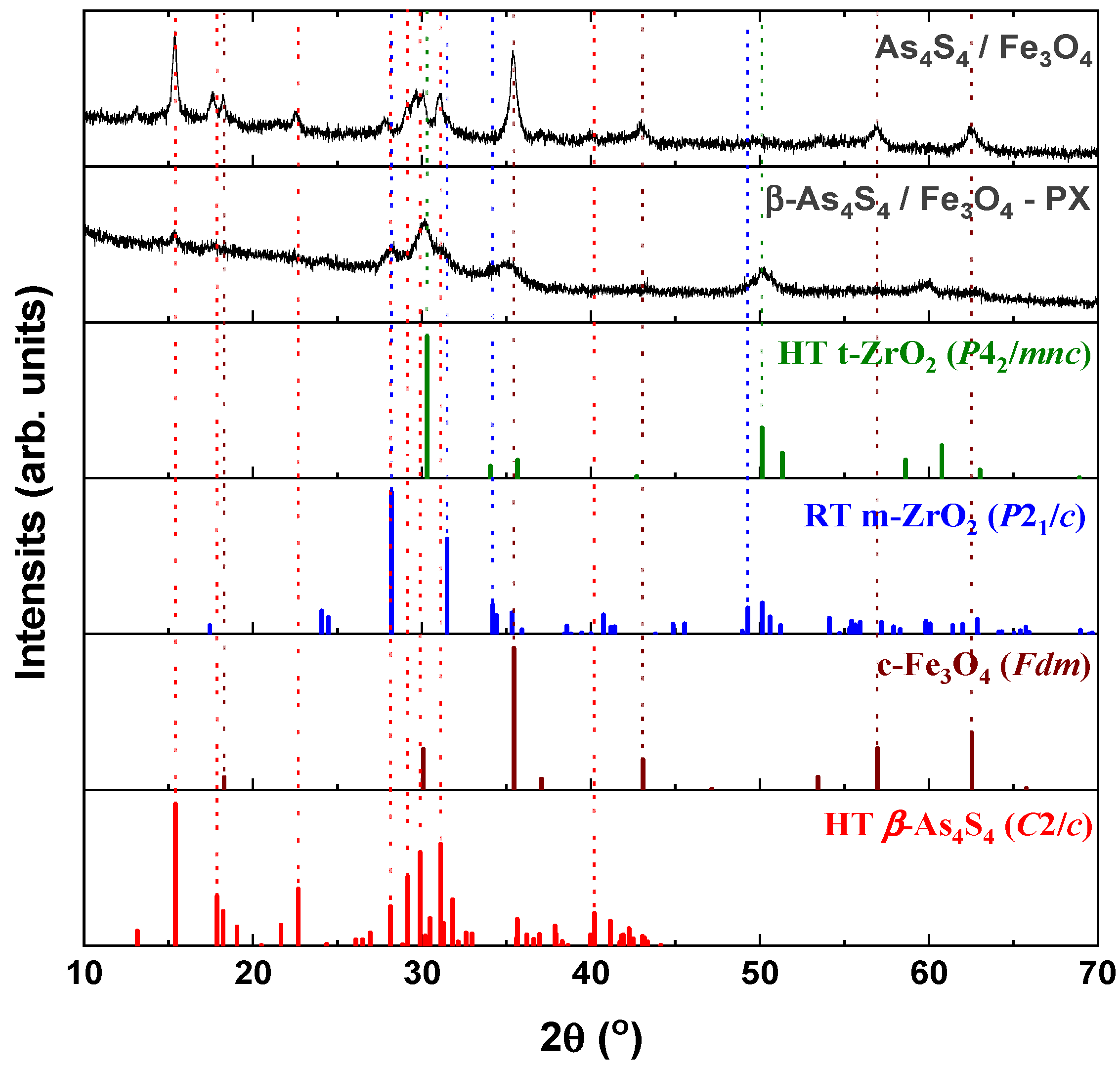

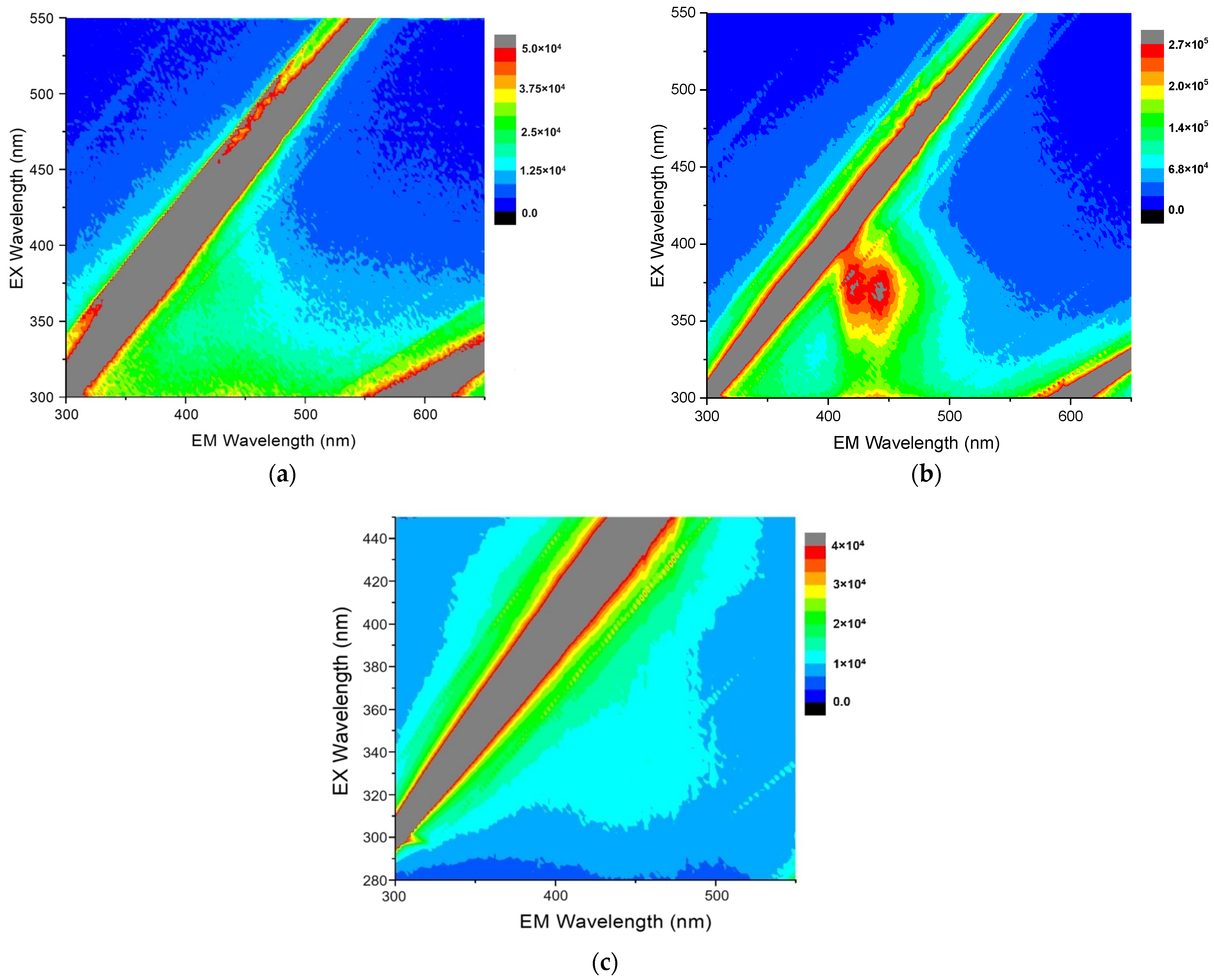
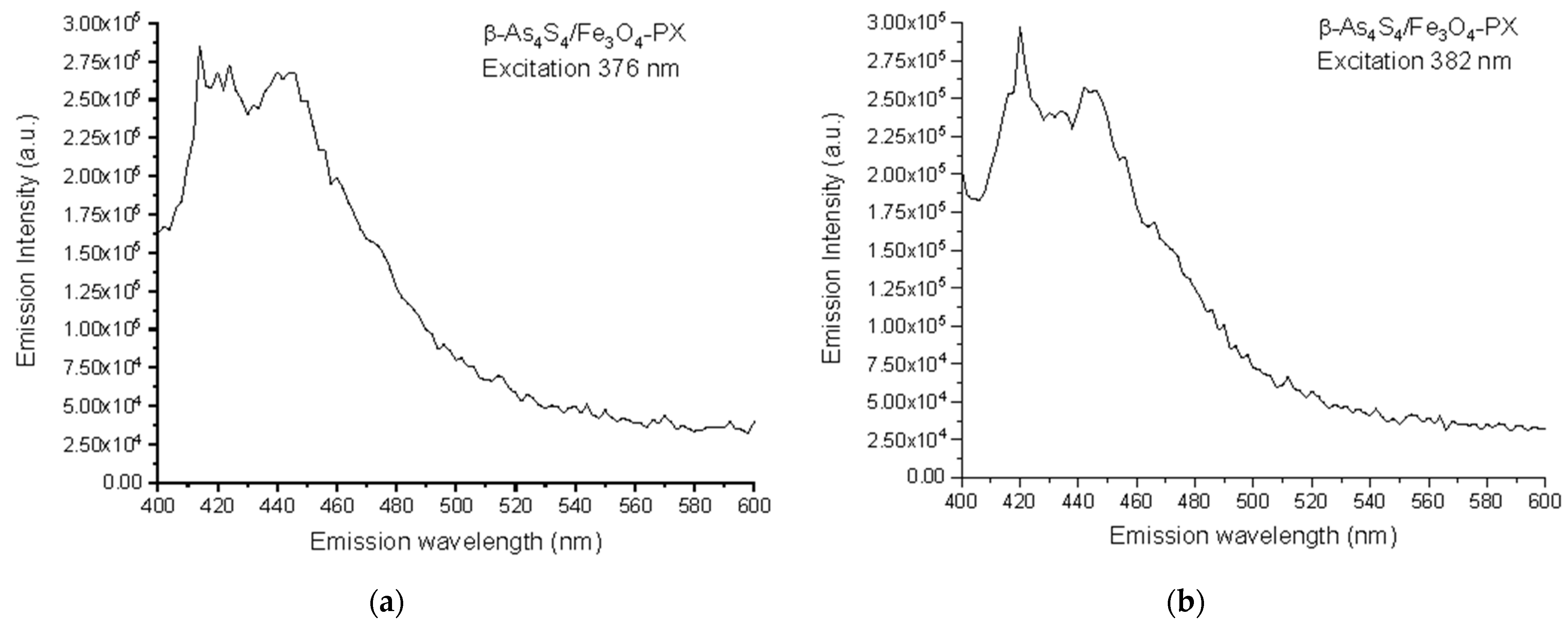
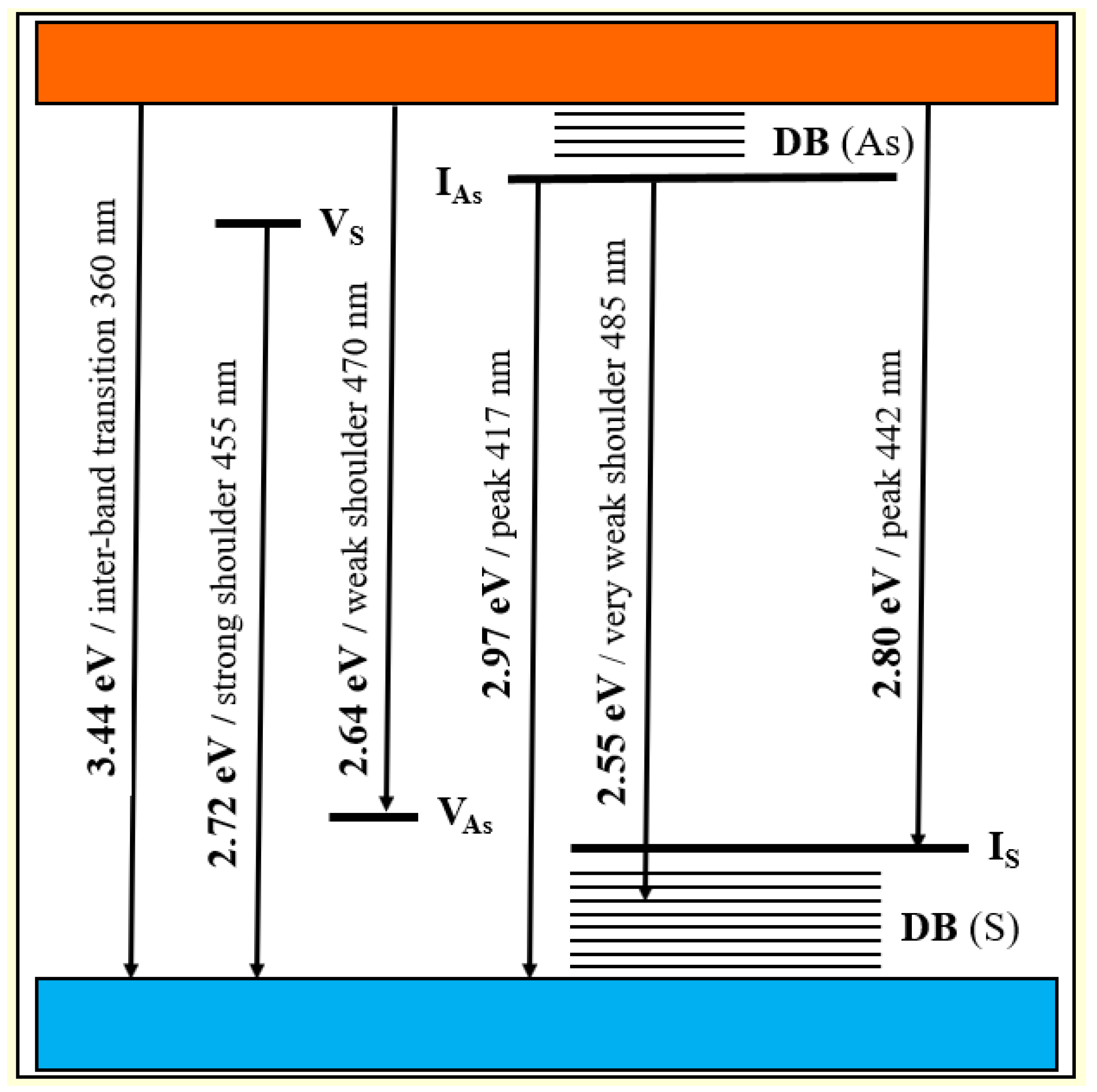
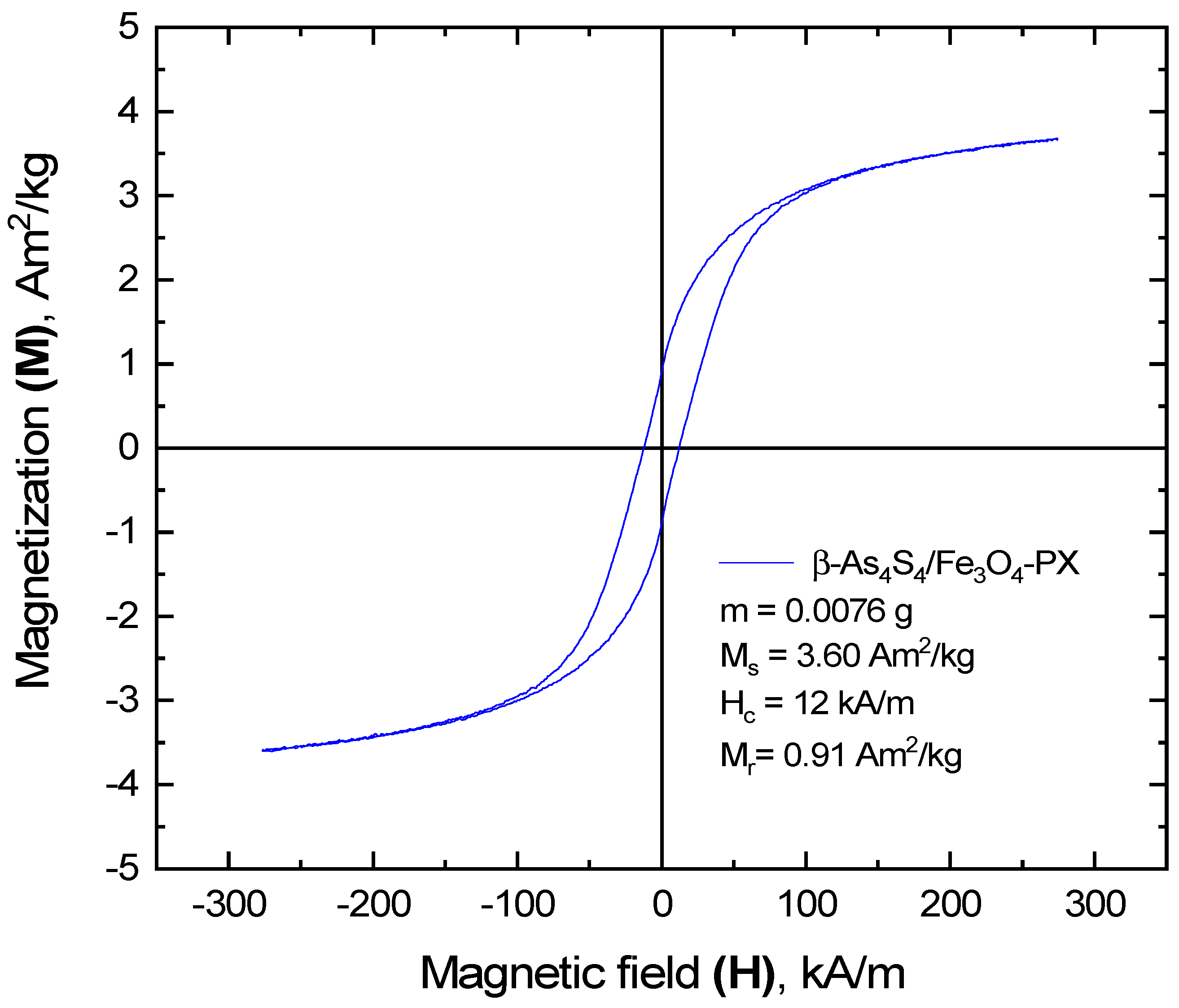
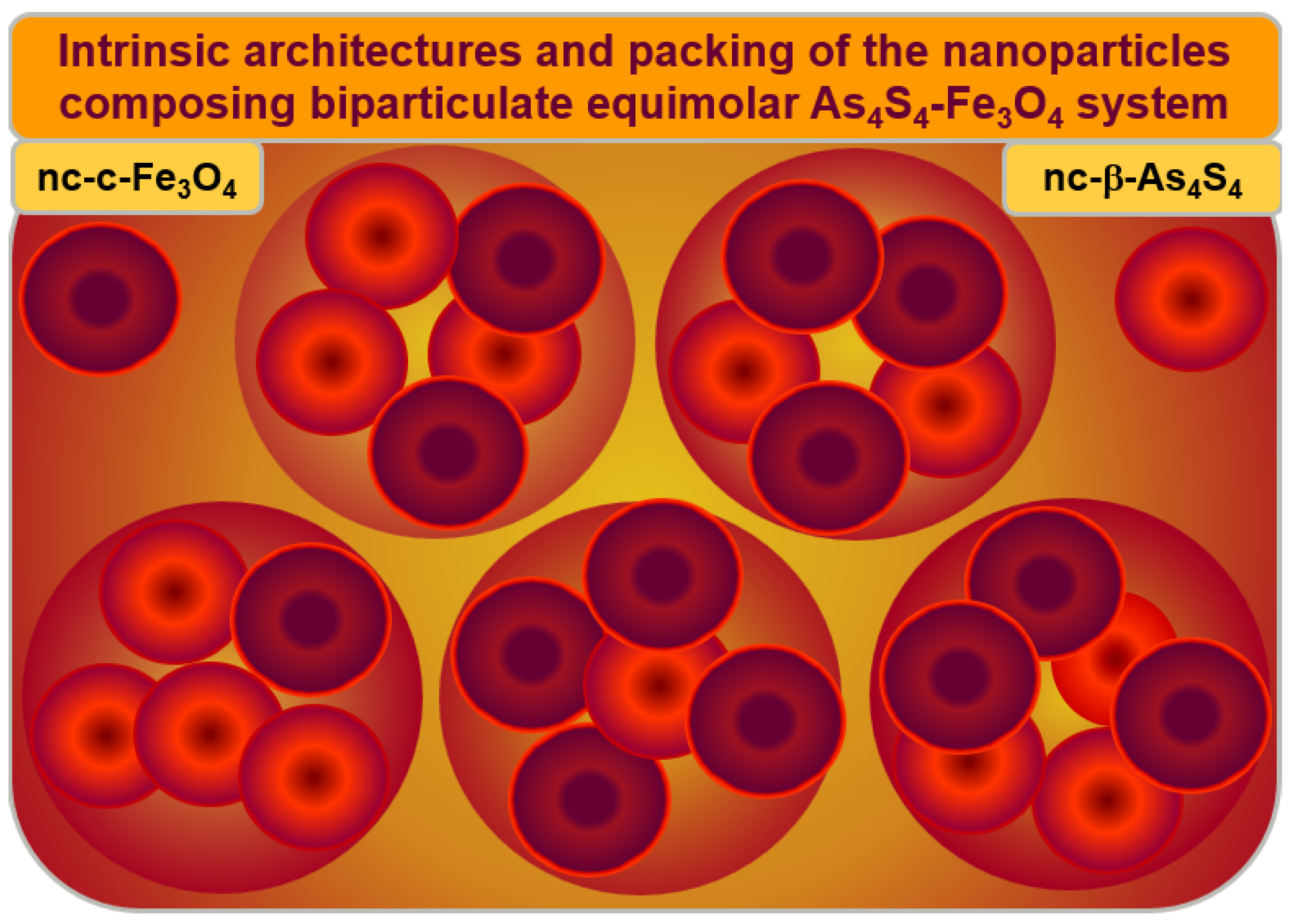
| MNP β-As4S4-Bearing Nanocomposite, Ref. | FSDP Parameters | ||||||
|---|---|---|---|---|---|---|---|
| 2Θ, | FWHM, | Q, Å−1 | ΔQ, Å−1 | R, Å | L, Å | ds, Å | |
| Bulk unmilled β-As4S4, [49,50] | 16.712 (13) | 4.35 (3) | 1.185 | 0.31 | 5.30 | 20.3 | 6.52 |
| Mono-particulate β-As4S4, [20,49] | 16.213 (7) | 3.57 (2) | 1.150 | 0.25 | 5.46 | 24.7 | 6.72 |
| Biparticulate 4·β-As4S4/1·Fe3O4, [20] | 16.197 (11) | 3.93 (4) | 1.149 | 0.28 | 5.47 | 22.5 | 6.73 |
| Biparticulate β-As4S4/Fe3O4, this study | 16.068 (28) | 4.64 (11) | 1.140 | 0.33 | 5.51 | 19.0 | 6.78 |
| Triparticulate β-As4S4/4·ZnS/Fe3O4, [23] | 15.077 (3) | 5.68 (14) | 1.070 | 0.40 | 5.87 | 24.2 | 7.22 |
Disclaimer/Publisher’s Note: The statements, opinions and data contained in all publications are solely those of the individual author(s) and contributor(s) and not of MDPI and/or the editor(s). MDPI and/or the editor(s) disclaim responsibility for any injury to people or property resulting from any ideas, methods, instructions or products referred to in the content. |
© 2024 by the authors. Licensee MDPI, Basel, Switzerland. This article is an open access article distributed under the terms and conditions of the Creative Commons Attribution (CC BY) license (https://creativecommons.org/licenses/by/4.0/).
Share and Cite
Shpotyuk, O.; Lukáčová Bujňáková, Z.; Baláž, P.; Kovalskiy, A.; Sznajder, M.; Cebulski, J.; Shpotyuk, Y.; Demchenko, P.; Syvorotka, I. Equimolar As4S4/Fe3O4 Nanocomposites Fabricated by Dry and Wet Mechanochemistry: Some Insights on the Magnetic–Fluorescent Functionalization of an Old Drug. Materials 2024, 17, 1726. https://doi.org/10.3390/ma17081726
Shpotyuk O, Lukáčová Bujňáková Z, Baláž P, Kovalskiy A, Sznajder M, Cebulski J, Shpotyuk Y, Demchenko P, Syvorotka I. Equimolar As4S4/Fe3O4 Nanocomposites Fabricated by Dry and Wet Mechanochemistry: Some Insights on the Magnetic–Fluorescent Functionalization of an Old Drug. Materials. 2024; 17(8):1726. https://doi.org/10.3390/ma17081726
Chicago/Turabian StyleShpotyuk, Oleh, Zdenka Lukáčová Bujňáková, Peter Baláž, Andriy Kovalskiy, Małgorzata Sznajder, Jozef Cebulski, Yaroslav Shpotyuk, Pavlo Demchenko, and Ihor Syvorotka. 2024. "Equimolar As4S4/Fe3O4 Nanocomposites Fabricated by Dry and Wet Mechanochemistry: Some Insights on the Magnetic–Fluorescent Functionalization of an Old Drug" Materials 17, no. 8: 1726. https://doi.org/10.3390/ma17081726
APA StyleShpotyuk, O., Lukáčová Bujňáková, Z., Baláž, P., Kovalskiy, A., Sznajder, M., Cebulski, J., Shpotyuk, Y., Demchenko, P., & Syvorotka, I. (2024). Equimolar As4S4/Fe3O4 Nanocomposites Fabricated by Dry and Wet Mechanochemistry: Some Insights on the Magnetic–Fluorescent Functionalization of an Old Drug. Materials, 17(8), 1726. https://doi.org/10.3390/ma17081726







